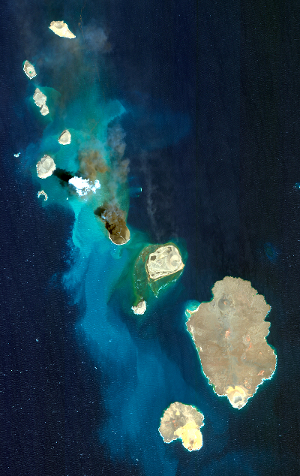Using AI to control energy for indoor agriculture
30 September 2024
Published online 31 May 2015
New research following the appearance of newly formed volcanic islands, a rare event, shows that the southern Red Sea region is more volcanically active than what was once thought.

© Nature Communications / Jónsson et al.
After more than 150 years of quiescence, volcanic eruptions occurred in the Red Sea in 2007, 2011, and 2013. The two latest eruptions created new volcanic islands, a remarkably rare occurrence.
Wenbin Xu and Joël Ruch, researchers in Sigurjón Jónsson's lab at KAUST, used seismic data and satellite interferometry to investigate the process underlying the eruptions and subsequent island building. They detected ground deformations and earthquake swarms preceding the eruptions, and thus determined that the southern Red Sea is undergoing a “rifting episode”, in which diverging tectonic plates rapidly release stresses built up over hundreds of years. Points far from the boundary, such as on opposite shores of the Red Sea, move apart by about one centimeter per year, but the crust just adjacent to the rift remains still, building up stress.
“It’s like you keep pulling on an elastic band,” explains Jónsson. “At some point, it snaps, and that's when you have a rifting episode.” Rifting episodes occur every few hundred years, suddenly shifting the crust near the rift several meters and altering the state of stress around it.
Jónsson hopes to learn how these stress changes affect the surrounding region. For example, the Afar region in east Africa was very active from 2005 to 2010. “It’s an intriguing question – did that episode affect the activity in the Red Sea? Is there some kind of interaction over this distance of 300-400km?” he asks.
The team also measured the size and shape of the new islands formed during the rifting episode. Although the islands initially shrank significantly, erosion has since slowed. “These islands won't erode away,” says Jónsson. “They’ll last for centuries.”
Jónsson warns however that the rifting episode may not be over, since the most recent activity was less than two years ago. “When you have meter-scale widening in only a few years, it significantly alters the state of the crust at distances of more than 100km. This can potentially trigger sizable earthquakes of magnitude 4, 5, or even over 6.”
Jónsson pointed out that though the zone is in a relatively remote region, potential larger volcanic events may disrupt shipping.
Cynthia Ebinger, a geophysicist asked by Nature about the work, says that lava flows and ash from volcanic eruptions may disrupt sea and air traffic, adding that “rifted margin volcanoes commonly erupt large volumes of sulfur dioxide and carbon dioxide, with an impact on the regional and potentially the global climate.”
doi:10.1038/nmiddleeast.2015.93
Stay connected: